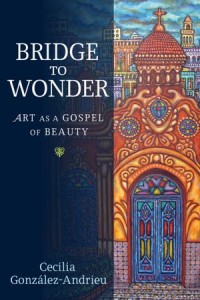Cecilia González-Andrieu: Bridge to Wonder
 Cecilia González-Andrieu, Bridge to Wonder: Art as a Gospel of Beauty (Waco, TX: Baylor University Press, 2012) vii + 242, ISBN 9781602583511.
Cecilia González-Andrieu, Bridge to Wonder: Art as a Gospel of Beauty (Waco, TX: Baylor University Press, 2012) vii + 242, ISBN 9781602583511.
In Bridge to Wonder: Art as a Gospel of Beauty Cuban-American theologian Cecilia González-Andrieu seeks to span the gulf between art and Christian theology through the image of the “revelatory and transforming beauty” (7) of San Francisco’s Golden Gate Bridge. As González-Andrieu sees it, the Golden Gate provides a fertile metaphor for understanding art’s unique bond to the Christian faith. To assess this venture calls for a brief sketch of the volume.
Bridge to Wonder begins by recounting the author’s everyday aesthetic experiences growing up in Cuba, as a graduate student perched in the Berkley hills across the from the Golden Gate Bridge, and amidst the awe-inspiring diversity of urban Los Angeles. Having framed the discussion in light of her personal journey, the second chapter sets about laying the theoretical footings for her project. Employing Avery Dulles’ work on “revelatory symbols,” González-Andrieu explores the prophetic power of art’s beauty to reconnect our (Western) post-Enlightenment gap between the visible and invisible. In turn, the third chapter (“In Search of Wonder”) elaborates on art’s wonder-making potency: a force capable of spawning humility, making us aware of our pain, enabling us to face difficult questions, and even (at times) revealing our need for salvation. Having offered theories regarding art’s revelatory-beauty and wonder-making potential the fourth chapter seeks to illustrate such in the United Kingdom’s 2000 National Gallery exhibit Seeing Salvation: Images of Christ in Art. This exhibit provides an apt case study for González-Andrieu; art being successful in “making Jesus Christ relevant to the culture where churches were failing” (60). The fifth chapter dives deeper into Seeing Salvation in order to further tease out art’s (theological) potency. By offering “windows” into “otherness” art provides a distinct way of knowing that draws us beyond the boundaries of our own expectations. The following chapter takes up methodology. In place of an “intersection” model of art and theology González-Andrieu proposes an “interlacing” model: the latter offering both multiple points of contact and an appreciation of differences between the two spheres. Because the work of interlacing calls for further clarity the seventh chapter exposits the nature of art and artists. According to González-Andrieu art is both “a work of human making that complicates the natural” and a calling undertaken by individuals offering “a gift that speaks to a community because it captures the spirit of that community.” Art thereby “critiques and energizes, bringing newness and clarity” (111). The ninth chapter (“Beauty in Turmoil”) bemoans, on the one hand, the disregard for beauty in contemporary art, and on the other hand, a covert colonialism that merely baptizes a particular cultural vantage point as the Beautiful. Offering a third way, González-Andrieu charges her readers to recognize the unique relationship of a particular cultural manifestation with “the source of all Beauty” (129). The final chapter takes up Sergio Gomez’s artwork as exemplary of a compassionate, truth-telling art that brings the true, the good and the beautiful together in a way that interlaces art and faith.
Charismatic and Pentecostal readers will find much to appreciate in González-Andrieu’s desire to link art’s power to move beyond the discursive, cognitive and propositional to a theology grounded in an experience that opens the imagination and moves one to “encounter ‘God in all things’” (110). For González-Andrieu the eye (beholder of signs and wonders) shares equal status with the ear (hearer of the word preached) as a vehicles of revelation. Likewise, as González-Andrieu also argues, both art and Christian revelation find their ultimate power not in what they mean, but in virtue of what they do. Even more, González-Andrieu’s desire to bridge art’s multitude of resplendent manifestations to the supreme Beauty behind it finds strong resonance with the many-tongued work of the Spirit; this being confirmed in González-Andrieu’s irenic tone and eagerness to invite those outside her Catholic tradition into the dialogue.
Category: Living the Faith, Winter 2014


